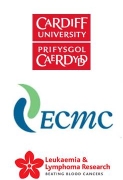About AML
 Acute
Myeloid Leukaemia (AML) and Myelodysplasia (MDS) are malignant
conditions of the bone marrow. They both result in failure of the bone
marrow to manufacture enough blood cells (red cells, white cells and
platelets), because the marrow contains too many leukaemia cells.
Acute
Myeloid Leukaemia (AML) and Myelodysplasia (MDS) are malignant
conditions of the bone marrow. They both result in failure of the bone
marrow to manufacture enough blood cells (red cells, white cells and
platelets), because the marrow contains too many leukaemia cells.
Within the AML18 Pilot Trial, there are two approaches to treatment
and these can be explained to you by your treatment team. The first
comprises up to 3 courses of intensive chemotherapy, given 4-6 weeks
apart usually as an inpatient. The aim of treatment is to kill off the
leukaemia cells and allow the marrow to work normally which is called
disease remission, and is expected to happen after the first or second
treatment course. Because there is a risk of the disease coming
back a further treatment is given. This approach has risks associated
with it. This approach may or may not be considered suitable for you.
The second approach is to use drugs to control the leukaemia cells in
the bone marrow rather than to try to get rid of them completely. This
approach is less intensive and some of the treatments can be given by
mouth and taken as an outpatient. The chances of the disease going into
complete remission are lower, but much less time in hospital is
required. For some patients, particularly those who are less fit or have
other medical conditions, this may be thought to be a better approach.
Which treatment approach is adopted for you will be decided after you
have had a discussion with your doctor.
The AML 18 Pilot trial is being undertaken in patients
where intensive chemotherapy is the chosen treatment approach and will
be undertaken in up to 14 treatment centres in the UK. The aim is to
test the effects of adding one of 2 new treatment agents to commonly
used chemotherapy combinations.

